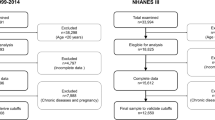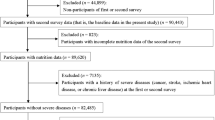Abstract
Objective: To assess the performance of low BMI, and define optimal BMI cut-off values in order to detect fever-associated adult morbidity.
Design: A cohort study of adults between 18 and 60 y in rural Vietnam, whose BMI and health status were assessed at baseline, and who were then monitored for illness events for 4 months. Nonparametric receiver operating characteristic (ROC) analysis was used to evaluate the performance of low BMI to detect the average number of restricted-days due to illness and to determine optimal cut-off values.
Setting: A rural commune in the Red River Delta, northern Vietnam.
Subjects: The study included 693 men and 739 women aged 18–60-y.
Results: At baseline, 21% of the study participants had a BMI<18.5 kg/m2. As BMI progressively decreased, the percentage of participants experiencing morbidity with fever increased. The areas under the ROC curves for BMI were significantly greater than 0.5 for all levels of monthly average restricted-days of illness (MARDI) with fever, with best performance for >5 days/month. Excluding participants with acute or chronic disease at baseline improved the performance of BMI to detect MARDI with fever of >5 days (area under ROC curve 0.95; 95% CI 0.92, 0.99). With increasing levels of MARDI with fever, BMI cut-offs fell to 17.9 kg/m2 when MARDI with fever was >5 days.
Conclusions: The ROC analysis demonstrates that low BMI performs well as a risk indicator of MARDI with fever of >5 days with an optimal BMI cut-off value of 17.9 kg/m2.
Sponsorship: Wellcome Trust Research Training Fellowship in Population Health.
This is a preview of subscription content, access via your institution
Access options
Subscribe to this journal
Receive 12 print issues and online access
$259.00 per year
only $21.58 per issue
Buy this article
- Purchase on Springer Link
- Instant access to full article PDF
Prices may be subject to local taxes which are calculated during checkout





Similar content being viewed by others
References
Begg CB (1991): Advances in statistical methodology for diagnostic medicine in the 1980's. Stat. Med. 10, 1887–1895.
Brownie C, Habicht JP & Cogill B (1986): Comparing indicators of health or nutritional status. Am. J. Epidemiol. 124, 1031–1044.
de Vasconcellos MT (1994): Body mass index: its relationship with food consumption and socioeconomic variables in Brazil. Eur. J. Clin. Nutr. 48 (Suppl 3), 115–123.
Ferro-Luzzi A, Sette S, Franklin M & James WP (1992): A simplified approach of assessing adult chronic energy deficiency. Eur. J. Clin. Nutr. 46, 173–186.
Francois PJ (1994) Unpublished data. FAO – UN 1990 Cited in Shetty PS, James WP Body mass index (BMI) — a measure of chronic energy deficiency in adults. FAO Food Nutr. Pap. 1–57.
Francois PJ & James WP (1994): An assessment of nutritional factors affecting the BMI of a population. Eur. J. Clin. Nutr. 48 (Suppl 3), 110–115.
Garcia M & Kennedy E (1994): Assessing the linkages between low body mass index and morbidity in adults: evidence from four developing countries. Eur. J. Clin. Nutr. 48 (Suppl 3), 90–96.
Giay T & Khoi HH (1994): Use of body mass index in the assessment of adult nutritional status in Vietnam. Eur. J. Clin. Nutr. 48 (Suppl 3), 124–130.
Greiner M (1996): Two-graph receiver operating characteristic (TG-ROC): update version supports optimisation of cut-off values that minimise overall misclassification costs. J. Immunol. Methods 191, 93–94.
Habicht JP & Stoltzfus RJ (1997): What do indicators indicate? Am. J. Clin. Nutr. 190–191.
James WP (1994): Introduction: the challenge of adult chronic energy deficiency. Eur. J. Clin. Nutr. 48 (Suppl 3), 1–8.
James WP, Ferro-Luzzi A & Waterlow JC (1988): Definition of chronic energy deficiency in adults — Report of a Working Party of the International Dietary Energy Consultative Group. Eur. J. Clin. Nutr. 42, 969–981.
James WP & Francois PJ (1984): The choice of cut-off point for distinguishing normal body weights from underweight or ‘chronic energy deficiency’ in adults. Eur. J. Clin. Nutr. 48 (Suppl 3), 179–184.
Jens B & Greiner M (1999): CMDT (Computational methods for diagnostic tests).
Naidu AN & Rao NP (1994): Body mass index: a measure of the nutritional status Indian populations. Eur. J. Clin. Nutr. 48 (Suppl 3), 131–140.
Pryer JA (1993): Body mass index and work-disabling morbidity: results from a Bangladeshi case study. Eur. J. Clin. Nutr. 47, 653–657.
Rice AL, Stoltzfus RJ, de Francisco A & Kjolhede CL (2000): Evaluation of serum retinol, the modified-relative-dose–response ratio, and breast-milk vitamin A as indicators of response to postpartum maternal vitamin A supplementation. Am. J. Clin. Nutr. 71, 799–806.
Shetty PS & James WP (1994): Body mass index (BMI) — a measure of chronic energy deficiency in adults. Rome FAO Food Nutr. Pap. 56, 1–57.
Stata Corporation™ (2001): Stata 7.0 College Station TX: Stata Corporation ™.
Strickland SS & Ulijaszek SJ (1994): Body mass index and illness in rural Sarawak. Eur. J. Clin. Nutr. 48 (Suppl 3), 98–108.
Veli K & Allan P (1996): GraphROC for windows version 2.0.
World Bank Poverty Net (2003) Technical guidelines for the qquantitative analysis of health equity. Available at: http://www.worldbank.org/poverty/health/wbact/health_eq.htm.
WHO Expert Committee (1995): Physical status: the use and interpretation of anthropometry. World Health Organization Technical Report Series 854, 345–374.
Zweig MH & Campbell G (1993): Receiver-operating characteristic (ROC) plots: a fundament evaluation tool in clinical medicine. Clin. Chem. 39, 561–577.
Acknowledgements
We are indebted to Dr Huy Vu D for revising the comorbidity questionnaire and assisting with interviewer training. We gratefully acknowledge the assistance of the staff of the National Institute of Nutrition, the Bavi Preventive Health Centre, and the Minh Quang People Committee in data collection. Support for this research was provided by the Wellcome Trust through a Research Training Fellowship in Population Health to the National Institute of Nutrition, Hanoi, Vietnam, and the University of Newcastle, Newcastle, Australia.
Author information
Authors and Affiliations
Contributions
Guarantor: Michael J Dibley.
Contributors: DTT designed the study, organized and monitored the collection of data, conducted data analysis and prepared the manuscript; MJD contributed to the design of the study, advised about data collection methods, and contributed to the analysis of data and preparation of the manuscript; CD'E provided advice about the design, especially the sampling strategy, and the analysis of data. No author has any financial or personal relationships with the organization sponsoring this research.
Corresponding author
Rights and permissions
About this article
Cite this article
Do, T., Dibley, M. & D'Este, C. Receiver operating characteristic analysis of body mass index to detect increased risk of functional morbidity in Vietnamese rural adults. Eur J Clin Nutr 58, 1594–1603 (2004). https://doi.org/10.1038/sj.ejcn.1602010
Received:
Revised:
Accepted:
Published:
Issue Date:
DOI: https://doi.org/10.1038/sj.ejcn.1602010
Keywords
This article is cited by
-
What Characterises Women Vulnerable to Chronic Energy Deficiency?
Social Indicators Research (2009)



